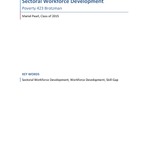Sectoral Workforce Development

View/
Author
Pearl, Mariel S.
Subject
Washington and Lee University, Shepherd Poverty Program
Occupational training
Vocational qualifications
Labor market
Capabilities approach (Social sciences)
Metadata
Show full item recordDescription
Mariel S. Pearl is a member of the Class of 2015 of Washington and Lee University. Capstone; [FULL-TEXT RESTRICTED TO WASHINGTON AND LEE UNIVERSITY LOGIN] Even after the recent recession, and despite a high unemployment rate, there are labor markets in which employers struggle to fill positions (Coffey 2011). In 2011, the Bureau of Labor Statistics projected that “nearly one half of all job openings in the years to come will be middle skill jobs” (defined as requiring more than a high school degree but less than a bachelors) (Cooney 2011). Yet, traditional workforce development programs do not provide low-skilled low-income workers with the qualifications needed to fill these open positions. . . . Workforce development has been challenged to find new ways to train and equip the next generation of workers. Yet, a new approach is growing in momentum: sectoral workforce development. [From Introduction]